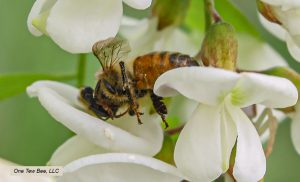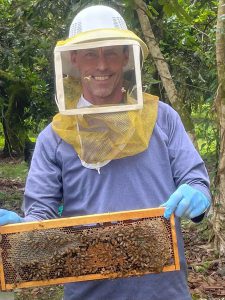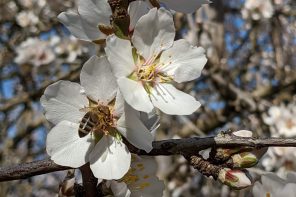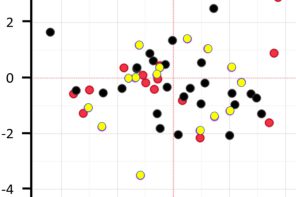Click Here if you listened. We’d love to know what you think. There is even a spot for feedback!
Read along below!
 Some Bee Behavior Bullets
Some Bee Behavior Bullets
A few of your questions with some suggested answers
By: James E. Tew
No shortage of questions
There is no shortage of honey bee questions, but answers are not always easy to derive. Following are some of the questions that have come up in the past during various classes I have given. No doubt, just a few years from now some of my responses will need to be reviewed. That’s a good thing. Our understanding is always increasing and improving.
What flower colors attract honey bees?
No specific color attracts or repels bees. Bees see ultraviolet, violet, blue, blue-green, yellow and orange. Bees do not see red or infrared. Under appropriate conditions, any flower that rewards a foraging bee with either pollen or nectar should be attractive.
Since bees do not see red, should I wear red-colored clothes when working around bees?
We don’t know for sure what a bee sees when exposed to red color, but a guess is that it is a drab color of purple. Wearing red clothes would not hurt, but neither will it be of a great help. Bees combine color vision with an awareness of smell, movement, magnetic forces and micro-electrical currents. White remains a good choice.
Has the longevity of the honey bee been altered by genetic engineering or by evolution?
The longevity of the honey bee has not yet been altered by genetic engineering. Someone may do that in the future. The process of evolution may have, during the bee’s long history, affected the bee’s life span one way or another, but we have no reason to think that the bee’s life span has ever been much different from what it is now. Improvements in beekeeper’s ability to recognize and control diseases has probably lengthened the bee’s life somewhat, but even that has not been clearly shown.
I have frequently heard the adage that a drone has no father but has a grandfather. How is that possible?
Normally, in most animals, fertilization must occur for a new organism to be produced. This is not true in insects. A drone will arise from an unfertilized egg in a process called parthenogenesis. A fertilized egg results in a worker or queen and requires normal fertilization procedures. Therefore, a drone had a grandfather (required to produce the drone’s mother), but due to parthenogenesis, did not have a father. Drones have only half as many chromosomes as workers and queens.
What are pheromones and how do they affect bees?
A pheromone is a chemical, produced by various glands of bees that produces a behavioral or physiological response in another bee of the same species. It is a chemical message that is usually produced as a liquid and transmitted as a liquid or vapor. Bees use pheromones to mark food sources, to help swarms issue and settle, as a call to colony defense, to identify different types of brood, in mating behavior and in many other ways. It is probably the most common way bees communicate within the dark hive.
Do bees really dance when they find food?
The word dance is our word. Bees are not dancing as such. When a forager finds a rewarding food source, she returns to the hive and goes through a ritualized re-enactment of the trip, which we call a dance. The specifics of the dance vary with races of bees, but in general, food sources farther than 100m from the colony result in the forager giving information about: (1) the distance, (2) the direction, (3) the taste, (4) the odor and (5) the quality or amount of the food source. Bees may also dance to indicate new colony nest sites and water sources.
How does the round dance vary from the wag-tail dance?
The round dance is really the same dance as the wag-tail – only nearer the hive and is performed in more of a circle format rather than the classic figure-8 pattern. In some races of bees, the round dance is used when food finds are as near as 10-12 yards from the hive.
Is it possible for one bee colony to be smarter than another? It seems that one of my hives is a better foraging unit and survives the Winter better.
Yes, there can be differences in learning abilities of different races of bees. Carniolans have been shown to learn to forage better than Italian bees if the feeding site was plainly marked. Also, Carniolans are better at harvesting honey dew than Italians. This is not a comparison of intelligence however, but rather an indicator of adaptation to different geographical areas.
What are the names of the best-known races of honey bees presently in the U.S.?
Apis mellifera, the common honey bee, has 24 races or subspecies, but there are four that are common worldwide and have been imported into the U.S.
- The Grey Caucasian Mountain Bee (Apis mellifera caucasica Gorbachev) are bees that are commonly called Caucasians.
- The Italian honey bee (Apis mellifera ligustica Spinola) is the most common honey bee race and has been spread over the world. The Italian bee is, by far, the most popular bee in the U.S.
- The Carniolan Bee (Apis mellifera carnica Pollman) is from the Austrian/Yugoslavian border.
- For many years, the Common European Black Bee (Apis mellifera mellifera) was the most popular honey bee in the U.S. The dark strain was aggressive and flighty and was replaced by the European strain.
It has been my impression that current beekeepers are more interested in varroa resistance and wintering success than in acquiring a designated race of honey bee exhibiting specific characteristics. If so, this is a significant change in queen breeding selectivity from preferences made during previous decades.

Figure 1. Basic stages of a developing honey bee. Egg, larva, older larvae (prepupal resting stage) and fully developed pupae.
What is bee brood?
Bee brood includes all stages of the immature bee – regardless of age. Bees undergo complete metamorphosis as they change from an egg to adult. The stages of development are egg, larvae (grub), pupae (resting stage) and adult.

Figure 2. This is about as full a brood frame as can be hoped for.
What’s the best way to get the queen to lay brood all the way to all edges of the frame?
The queen, with the assistance of her workers, avoids putting brood in areas near the walls or near the opening of the hive. To develop properly, bee brood requires a stable temperature of 93-96°F. Air temperatures can quickly change in the areas near the nest periphery that will disrupt brood development. There is no common beekeeping procedure that will encourage a queen to produce brood along the outer edges of the brood nest. Possibly providing some form of insulation on the outside of the hive could help.
Does a bee egg actually hatch like a bird egg?
No. The outer covering of the bee egg, called the chorion, dissolves as the larvae within the egg is becoming ready to emerge. The egg, which is attached to the cell base by the smaller end, gently lays over on the cell base to change from an egg to a very small “c” shaped larva. In essence, the bee egg shell dissolves rather than breaks open.
How long does the larval stage last?
The larvae stage of the worker bee last six days.
Several times while attending talks on bee breeding and genetics, I have heard the term “super sister” used. I understand what half-sisters and sisters are, but what are super sisters? Do they look any different from normal bees?
If a queen mates with drones that are her brothers, the workers she produces are super sisters. If the queen mates with drones that have the same mother, the workers she produces are full sisters. If the queen mates with drones that have different mothers, the workers she produces are half-sisters. Super sisters do not look any different from workers that are half-sisters or full sisters and are not considered to be abnormal.
Why do some fertile eggs become workers while others become queens? Is it just a food difference as I have read?
To an extent, it is a food difference. A developing queen is fed a highly nutritious diet having a hormonal component throughout her development. Workers, on the other hand, are fed the special diet for about three days and then for the remainder of their development are then fed a diet composed predominantly of undigested pollen and carbohydrates.
Just exactly what is “queen substance”?
Queen substance is really several chemicals (pheromones) secreted by the mandibular gland of the queen. Inhibition of worker ovaries, sex attractant and swarm stabilization are examples of the activities of queen substance. These compounds are accumulated by workers when they touch, groom or feed the queen and are then passed from bee to bee during food exchange and physical contact.
Artificial sweetener is inexpensive and easy to mix compared to sugar. Can I use it to make sugar syrup for feeding bees?
No. Honey bees do not have the same taste perception as humans. Though artificial sweeteners are obvious to us, bees ignore it. They may collect it as a water source, but not as a nectar source.
Why do honey bees occasionally collect sweat? I’ve noticed that on Summer days, worker bees lick perspiration from my arms.
I can’t say for sure, but there are several possibilities. Bees, as do most animals, require salt for normal physiological functions. In fact, foraging bees are commonly seen collecting water from salt blocks in animal feed lots. They need salt in their diet. However, they may be collecting trace elements or minerals, while we are only aware of the salt that’s present. Under extreme water shortage conditions, they may simply need water and are collecting it wherever it can be found.
How well developed is the honey bee’s sense of taste?
The honey bee can taste sweet, sour, salty and bitter flavors. They are especially good at detecting low levels of salt and sugar.
What’s this about a honey bee not being able to mathematically fly? Someone’s obviously wrong.
This is one question that just won’t go away. First, it was a bumblebee that was reported to be mathematically unable to fly – not the honey bee, and that, too, was wrong. Indeed, it seems that there were problems with the mathematical calculations. Obviously, both insects readily fly. Also, no consideration was given to most bees and wasps technique of connecting the rear wing to the front wing before taking to the air. When connected with wing hooks (hamuli) connect, the two larger wings have more lift than the four smaller unconnected wings. Both bumblebees and honey bees are excellent flyers.

Figure 3. Worker bees scenting to help a swarm arrive.
What happens when a honey bee “scents”?
Honey bee workers will “scent” to help orient other honey bees to such things as a food source, a new nest site, to a queen or to help settle a swarm. The Nasanov gland produces a combination of (1) (E)-and (Z)-citrals, (2) geraniol and (3) nerolic and geranic acids. The scent gland is on top of the honey bee’s seventh abdominal segment. When the gland is exposed by the bee, she fans her wings to force the airborne chemicals away from the worker’s abdomen thereby exposing nearby bees to the actions of the pheromone.

Figure 4. One worker feeding another worker.
In my observation hive and while observing bees on combs, I have noticed bees feeding each other. Can all bees feed themselves and can the drone and queen also feed themselves?
Food sharing (trophallaxis) among workers, drones and the queen is common. In fact, it’s required for various chemicals to be distributed throughout the colony. Newly emerged bees may have initial difficulties soliciting food from other workers, but they learn quickly. All workers, drones and queens can feed themselves when necessary.

Figure 5. This drone bee strangely has no father, but presumptively does have excellent eyesight. Note how his eyes come together on the top of his head.
In addition to being larger than workers, a drone appears to have larger eyes. Is that true and can drones see better than workers?
The drone does have larger eyes than the worker or queen, but it’s anyone’s guess whether or not the drone can actually see better than a worker. A drone’s eyes completely touch on top of the drone’s head. That can be a useful feature when learning to distinguish drones from workers.

Figure 6. Is this bee just napping? No, it’s strangely dead on a locust blossom.
I know honey bees can’t close their eyes, but do they sleep at night?
Many years ago, I was specifically told that, bees, and all other insects, do not sleep. More recent research has shown that bees at night, pass through a physiological state that is like mammalian sleep. It would seem that bees do have periods of inactivity akin to our concept of sleep.
Can bees hear?
This one is tricky to answer. Dr. H. Spangler, ARS USDA, Tucson, Arizona published work many years ago indicating that bees did respond to sound. He showed that bees briefly stopped movement when exposed to the sound waves produced by a vibrating “C” tuning fork. The effect was very short lived.
Honey bees do have close range hearing structures that are used while dancing to announce a successful foraging trip. The Johnston’s organs found within the honey bees’ antennae are a collection of sensory cells that are sensitive to vibration. They are found in the second segment (pedicel) of the antennae, and each detects minute motion of the end segment (flagellum). A thorough article on sound generation and hearing in honey bees was published by Collinson in Bee Culture, February 2016.
Honey bee workers share the work inside the hive. What is the specific breakdown of all the tasks? Does the queen oversee the activities of the workers?
During a normal lifetime, honey bee workers move through a transition of duties much like a student going through school grades. Unless the hive has been exposed to some form of stress, a worker will: (1) clean cells, (2) feed brood, (3) cap brood, (4) attend the queen (5) groom and feed nestmates, (6) ventilate the hive, (7) build comb, (8) receive and store nectar, (9) hive defense (about 20% of the workers will participate), (10) pack pollen and (11) forage. Changes in the worker bee’s exocrine system dictates the movement from one task to another – not the queen.
What happens in a hive if, say for instance, nurse bees are needed more than guard bees? Can the bees perform functions that they have stopped doing?
It appears that workers can either go backwards or forward in work assignments as needed by the hive. However, glandular secretions in older bees trying to regress are probably not as much as secretions in younger bees.
I was surprised to hear that the queen is not really in charge of the colony, but rather a consort of young nurse workers. The queen seems so special while all the workers seem just be one of the masses. Is there any more information on the subject?
We don’t know exactly who runs the nest show, but the nurse bees are able to know exactly what the brood nest needs at any given time. The queen certainly has her assignment – producing thousands of eggs and producing pheromones needed to stabilize the colony. She probably would not be best used in constantly analyzing colony needs. Young workers do seem to be in a somewhat surprising position of authority within the colony.
We could go on and on
I have always enjoyed studying honey bee behavior and biology. Understanding their life, so much as we can, makes us better beekeepers. I thank you for reading this piece.
 Dr. James E. Tew
Dr. James E. Tew
Emeritus Faculty, Entomology
The Ohio State University
tewbee2@gmail.com
Co-Host, Honey Bee Obscura Podcast
www.honeybeeobscura.com








